Louis Agassiz
Jean Louis Rodolphe Agassiz (/ˈæɡəsi/; French: [aɡasi]; May 28, 1807 – December 14, 1873) was a Swiss biologist and geologist recognized as an innovative and prodigious scholar of Earth's natural history. Agassiz grew up in Switzerland. He received doctor of philosophy and medical degrees at Erlangen and Munich, respectively. After studying with Cuvier and Humboldt in Paris, Agassiz was appointed professor of natural history at the University of Neuchâtel. He emigrated to the United States in 1847 after visiting Harvard University. He went on to become professor of zoology and geology at Harvard, to head its Lawrence Scientific School, and to found its Museum of Comparative Zoology.
Louis Agassiz ForMemRS | |
|---|---|
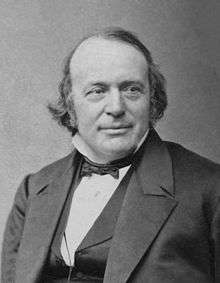 | |
| Born | May 28, 1807 Haut-Vully, Switzerland |
| Died | December 14, 1873 (aged 66) |
| Citizenship | United States |
| Alma mater | University of Erlangen-Nuremberg |
| Known for | Ice age, Polygenism |
| Spouse(s) | Cecilie Braun Elizabeth Cabot Cary |
| Children | Alexander, Ida, and Pauline |
| Awards | Wollaston Medal (1836) |
| Scientific career | |
| Fields | |
| Institutions | University of Neuchâtel Harvard University Cornell University |
| Doctoral advisor | Carl Friedrich Philipp von Martius |
| Other academic advisors | Ignaz Döllinger, Georges Cuvier, Alexander von Humboldt[1] |
| Notable students | William Stimpson, William Healey Dall, Carl Vogt[1] |
| Signature | |
 | |
Agassiz is known for his regimen of observational data gathering and analysis. He made vast institutional and scientific contributions to zoology, geology, and related areas, including writing multivolume research books running to thousands of pages. He is particularly known for his contributions to ichthyological classification, including of extinct species such as megalodon, and to the study of geological history, including to the founding of glaciology.
In the 20th and 21st centuries, Agassiz's resistance to Darwinian evolution, belief in creationism, and the scientific racism implicit in his writings on human polygenism have tarnished his reputation, and led to controversies over his legacy.
Early life
Louis Agassiz was born in Môtier (now part of Haut-Vully) in the Swiss canton of Fribourg. The son of a pastor,[2] Agassiz was educated first at home; he then spent four years of secondary school in Bienne, entering in 1818 and completing his elementary studies in Lausanne. Agassiz studied successively at the universities of Zürich, Heidelberg, and Munich; while there, he extended his knowledge of natural history, especially of botany. In 1829, he received the degree of doctor of philosophy at Erlangen, and in 1830, that of doctor of medicine at Munich.[3] Moving to Paris, he came under the tutelage of Alexander von Humboldt (and later his financial benevolence).[4] Humboldt and Georges Cuvier launched him on his careers of geology and zoology, respectively. Ichthyology soon became a focus of his life's work.[5]
Work

In 1819–1820, German biologists Johann Baptist von Spix and Carl Friedrich Philipp von Martius undertook an expedition to Brazil. They returned home to Europe with many natural objects, including an important collection of the freshwater fish of Brazil, especially of the Amazon River. Spix, who died in 1826, did not live long enough to work out the history of these fish, and Martius selected Agassiz for this project. Agassiz threw himself into the work with an enthusiasm that would go on to characterize the rest of his life's work. The task of describing the Brazilian fish was completed and published in 1829. This was followed by research into the history of fish found in Lake Neuchâtel. Enlarging his plans, in 1830, he issued a prospectus of a History of the Freshwater Fish of Central Europe. In 1839, however, the first part of this publication appeared, and it was completed in 1842.[3]
In 1832, Agassiz was appointed professor of natural history at the University of Neuchâtel. The fossil fish in the rock of the surrounding region, the slates of Glarus and the limestones of Monte Bolca, soon attracted his attention. At the time, very little had been accomplished in their scientific study. Agassiz, as early as 1829, planned the publication of a work, which more than any other, laid the foundation of his worldwide fame. Five volumes of his Recherches sur les poissons fossiles (Research on Fossil Fish) were published from 1833 to 1843. They were magnificently illustrated, chiefly by Joseph Dinkel.[6] In gathering materials for this work, Agassiz visited the principal museums in Europe, and meeting Cuvier in Paris, he received much encouragement and assistance from him.[3] They had known him for seven years at the time.
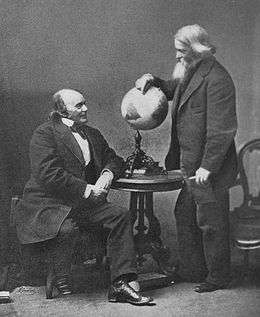
Agassiz found that his palaeontological analyses required a new ichthyological classification. The fossils he examined rarely showed any traces of the soft tissues of fish, but, instead, consisted chiefly of the teeth, scales, and fins, with the bones being perfectly preserved in comparatively few instances. He, therefore, adopted a classification that divided fish into four groups: ganoids, placoids, cycloids, and ctenoids, based on the nature of the scales and other dermal appendages. This did much to improve fish taxonomy, but Aggasiz's classification has since been superseded.[3]
Agassiz needed financial support to continue his work. The British Association and the Earl of Ellesmere—then Lord Francis Egerton—stepped in to help. The 1,290 original drawings made for the work were purchased by the Earl, and presented by him to the Geological Society of London. In 1836, the Wollaston Medal was awarded to Agassiz by the council of that society for his work on fossil ichthyology; and, in 1838, he was elected a foreign member of the Royal Society. Meanwhile, invertebrate animals engaged his attention. In 1837, he issued the "Prodrome" of a monograph on the recent and fossil Echinodermata, the first part of which appeared in 1838; in 1839–40, he published two quarto volumes on the fossil echinoderms of Switzerland; and in 1840–45, he issued his Études critiques sur les mollusques fossiles (Critical Studies on Fossil Mollusks).[3]
Before Agassiz's first visit to England in 1834, Hugh Miller and other geologists had brought to light the remarkable fossil fish of the Old Red Sandstone of the northeast of Scotland. The strange forms of Pterichthys, Coccosteus and other genera were then made known to geologists for the first time. They were of intense interest to Agassiz, and formed the subject of a monograph by him published in 1844–45: Monographie des poissons fossiles du Vieux Grès Rouge, ou Système Dévonien (Old Red Sandstone) des Îles Britanniques et de Russie (Monograph on Fossil Fish of the Old Red Sandstone, or Devonian System of the British Isles and of Russia).[3] In the early stages of his career in Neuchatel, Agassiz also made a name for himself as a man who could run a scientific department well. Under his care, the University of Neuchâtel soon became a leading institution for scientific inquiry.
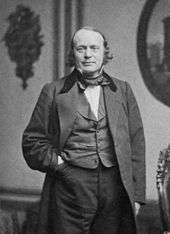
In 1842–1846, Agassiz issued his Nomenclator Zoologicus, a classification list, with references, of all names used in zoological genera and groups.
Ice age
In 1837, Agassiz proposed that the Earth had been subjected to a past ice age.[7] He presented the theory to the Helvetic Society that not only had ancient glaciers flowed outward from the Alps, but even larger glaciers had covered the plains and mountains of Europe, Asia, and North America, smothering the entire Northern Hemisphere in a prolonged ice age. In the same year, he was elected a foreign member of the Royal Swedish Academy of Sciences. Prior to this proposal, Goethe, de Saussure, Venetz, Jean de Charpentier, Karl Friedrich Schimper, and others had studied the glaciers of the Alps, and Goethe,[8] Charpentier, and Schimper[7] had even concluded that the erratic blocks of alpine rocks scattered over the slopes and summits of the Jura Mountains had been moved there by glaciers. These ideas attracted the attention of Agassiz, and he discussed them with Charpentier and Schimper, whom he accompanied on successive trips to the Alps. Agassiz even had a hut constructed upon one of the Aar Glaciers, which for a time he made his home, to investigate the structure and movements of the ice.[3]
In 1840, Agassiz published a two-volume work entitled Études sur les glaciers (Studies on Glaciers).[9] In this, he discussed the movements of the glaciers, their moraines, and their influence in grooving and rounding the rocks and in producing the striations and roches moutonnees seen in Alpine-style landscapes. He accepted Charpentier and Schimper's idea that some of the alpine glaciers had extended across the wide plains and valleys of the Aar and Rhône, but he went further, concluding that, in the recent past, Switzerland had been covered with one vast sheet of ice, originating in the higher Alps and extending over the valley of northwestern Switzerland to southern slopes of the Jura. The publication of this work gave fresh impetus to the study of glacial phenomena in all parts of the world.[10]
Familiar, then, with recent glaciation, Agassiz and English geologist William Buckland visited the mountains of Scotland in 1840. There, they found clear evidence in different locations of glacial action. The discovery was announced to the Geological Society of London in successive communications. The mountainous districts of England, Wales, and Ireland were understood to have been centres for the dispersion of glacial debris. Agassiz remarked, "that great sheets of ice, resembling those now existing in Greenland, once covered all the countries in which unstratified gravel (boulder drift) is found; that this gravel was in general produced by the trituration of the sheets of ice upon the subjacent surface, etc."[11]

United States
With the aid of a grant of money from the King of Prussia, Agassiz crossed the Atlantic in the autumn of 1846 to investigate the natural history and geology of North America and to deliver a course of lectures on "The Plan of Creation as shown in the Animal Kingdom,"[12] by invitation from J. A. Lowell, at the Lowell Institute in Boston, Massachusetts. The financial offers presented to him in the United States induced him to settle there, where he remained to the end of his life.[11] He was elected a foreign honorary member of the American Academy of Arts and Sciences in 1846.[13] Agassiz had a cordial relationship with Harvard botanist Asa Gray, but they disagreed on some scientific issues.[14] For example, Agassiz was a member of the Scientific Lazzaroni, a group of mostly physical scientists who wanted American academia to mimic the autocratic academic structures of European universities, whereas Gray was a staunch opponent of that group. Agassiz also felt each human race had different origins, but Gray believed in the unity of all humans.[15]
Agassiz's engagement for the Lowell Institute lectures precipitated the establishment, in 1847, of the Lawrence Scientific School at Harvard University, with Agassiz as its head.[16] Harvard appointed him professor of zoology and geology, and he founded the Museum of Comparative Zoology there in 1859, serving as the museum's first director until his death in 1873. During his tenure at Harvard, Agassiz studied the effect of the last ice age on North America.
Agassiz continued his lectures for the Lowell Institute. In succeeding years, he gave lectures on "Ichthyology" (1847–48 season), "Comparative Embryology" (1848–49), "Functions of Life in Lower Animals" (1850–51), "Natural History" (1853–54), "Methods of Study in Natural History" (1861–62), "Glaciers and the Ice Period" (1864–65), "Brazil" (1866–67), and "Deep Sea Dredging" (1869–70).[17] In 1850, he married an American college teacher, Elizabeth Cabot Cary, who later wrote introductory books about natural history and a lengthy biography of her husband after he died.[18]
Agassiz served as a nonresident lecturer at Cornell University while also being on faculty at Harvard.[19] In 1852, he accepted a medical professorship of comparative anatomy at Charlestown, Massachusetts, but resigned in two years.[11] From this time, Agassiz's, scientific studies dropped off, but he became one of the best-known scientists in the world. By 1857, Agassiz was so well-loved that his friend Henry Wadsworth Longfellow wrote "The fiftieth birthday of Agassiz" in his honor, and read it at a dinner given for Agassiz by the Saturday Club in Cambridge.[11] His own writing continued with four (of a planned 10) volumes of Natural History of the United States, published from 1857 to 1862. He also published a catalog of papers in his field, Bibliographia Zoologiae et Geologiae, in four volumes between 1848 and 1854.
Stricken by ill health in the 1860s, Agassiz resolved to return to the field for relaxation and to resume his studies of Brazilian fish. In April 1865, he led a party to Brazil. Following his return in August 1866, an account of this expedition, entitled A Journey in Brazil, was published in 1868. In December 1871, he made a second eight-month excursion, known as the Hassler expedition under the command of Commander Philip Carrigan Johnson (brother of Eastman Johnson), visiting South America on its southern Atlantic and Pacific seaboards. The ship explored the Magellan Strait, drawing the praise of Charles Darwin.
Elizabeth Agassiz wrote, at the Strait: '. ... .the Hassler pursued her course, past a seemingly endless panorama of mountains and forests rising into the pale regions of snow and ice, where lay glaciers in which every rift and crevasse, as well as the many cascades flowing down to join the waters beneath, could be counted as she steamed by them. ... These were weeks of exquisite delight to Agassiz. The vessel often skirted the shore so closely that its geology could be studied from the deck.'
Legacy
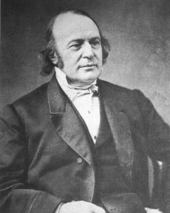
From his first marriage to Cecilie Bruan, Agassiz had two daughters in addition to son Alexander.[20] In 1863, Agassiz's daughter Ida married Henry Lee Higginson, who later founded the Boston Symphony Orchestra and was a benefactor to Harvard and other schools. On November 30, 1860, Agassiz's daughter Pauline was married to Quincy Adams Shaw (1825–1908), a wealthy Boston merchant and later benefactor to the Boston Museum of Fine Arts.[21]
In the last years of his life, Agassiz worked to establish a permanent school where zoological science could be pursued amid the living subjects of its study. In 1873, a private philanthropist (John Anderson) gave Agassiz the island of Penikese, in Buzzards Bay, Massachusetts (south of New Bedford), and presented him with $50,000 to permanently endow it as a practical school of natural science, especially devoted to the study of marine zoology.[11] The John Anderson school collapsed soon after Agassiz's death; it is considered a precursor of the Woods Hole Marine Biological Laboratory, which is nearby.[22]
Agassiz had a profound influence on the American branches of his two fields, teaching many future scientists who would go on to prominence, including Alpheus Hyatt, David Starr Jordan, Joel Asaph Allen, Joseph Le Conte, Ernest Ingersoll, William James, Charles Sanders Peirce, Nathaniel Shaler, Samuel Hubbard Scudder, Alpheus Packard, and his son Alexander Emanuel Agassiz, among others. He had a profound impact on paleontologist Charles Doolittle Walcott and natural scientist Edward S. Morse. Agassiz had a reputation for being a demanding teacher. He would allegedly "lock a student up in a room full of turtle-shells, or lobster-shells, or oyster-shells, without a book or a word to help him, and not let him out till he had discovered all the truths which the objects contained."[23] Two of Agassiz's most prominent students detailed their personal experiences under his tutelage: Scudder, in a short magazine article for Every Saturday,[24] and Shaler, in his Autobiography.[25] These and other recollections were collected and published by Lane Cooper in 1917,[26] which Ezra Pound was to draw on for his anecdote of Agassiz and the sunfish.[27]
In the early 1840s, Agassiz named two fossil fish species after Mary Anning —Acrodus anningiae, and Belenostomus anningiae— and another after her friend, Elizabeth Philpot. Anning was a paleontologist known around the world for important finds, but because of her gender, she was often not formally recognized for her work. Agassiz was grateful for the help the women gave him in examining fossil fish specimens during his visit to Lyme Regis in 1834.[28]
Agassiz died in Cambridge, Massachusetts, in 1873 and was buried at Mount Auburn Cemetery, joined later by his wife. His monument is a boulder from a glacial moraine of the Aar near the site of the old Hôtel des Neuchâtelois, not far from the spot where his hut once stood; his grave is sheltered by pine trees from his old home in Switzerland.[11]
The Cambridge elementary school north of Harvard University was named in his honor and the surrounding neighborhood became known as "Agassiz" as a result. The school's name was changed to the Maria L. Baldwin School on May 21, 2002, due to concerns about Agassiz's involvement in scientific racism, and to honor Maria Louise Baldwin the African-American principal of the school, who served from 1889 until 1922.[29][30] The neighborhood, however, continues to be known as Agassiz.[31] An elementary school called the Agassiz Elementary School in Minneapolis, Minnesota, existed from 1922 to 1981.[32]
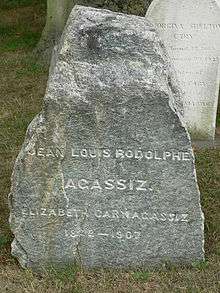
An ancient glacial lake that formed in the Great Lakes region of North America, Lake Agassiz, is named after him, as are Mount Agassiz in California's Palisades, Mount Agassiz, in the Uinta Mountains, Agassiz Peak in Arizona, and in his native Switzerland, the Agassizhorn in the Bernese Alps. Agassiz Glacier (Montana) and Agassiz Creek in Glacier National Park and Agassiz Glacier (Alaska) in Saint Elias Mountains, Mount Agassiz in Bethlehem, New Hampshire in the White Mountains also bear his name. A crater on Mars Crater Agassiz[33] and a promontorium on the moon are also named in his honor. A headland situated in Palmer Land, Antarctica, is named in his honor, Cape Agassiz. A main-belt asteroid named 2267 Agassiz is also named in association with Louis Agassiz.
Several animal species are named in honor of Louis Agassiz, including Apistogramma agassizii Steindachner, 1875 (Agassiz's dwarf cichlid); Isocapnia agassizi Ricker, 1943 (a stonefly); Publius agassizi (Kaup, 1871) (a passalid beetle); Xylocrius agassizi (LeConte, 1861) (a longhorn beetle); Exoprosopa agassizii Loew, 1869 (a bee fly); Chelonia agassizii Bocourt, 1868 (Galápagos green turtle);[34] Philodryas agassizii (Jan, 1863) (a South American snake);[34] and the most well-known, Gopherus agassizii (Cooper, 1863) (the desert tortoise).[34]. More recently in 2020, a new genus of pycnodont fish (Actinopterygii, Pycnodontiformes) named Agassazilia erfoundina (Cooper and Martill, 2020) from the Moroccan Kem Kem Group was named in honor of Agassiz who first identified the group in the 1830s.
In 2005, the European Geosciences Union Division on Cryospheric Sciences established the Louis Agassiz Medal, awarded to individuals in recognition of their outstanding scientific contribution to the study of the cryosphere on Earth or elsewhere in the solar system.[35]
Agassiz took part in a monthly gathering called the Saturday Club at the Parker House, a meeting of Boston writers and intellectuals. He was, therefore, mentioned in a stanza of the Oliver Wendell Holmes Sr. poem "At the Saturday Club":
There, at the table's further end I see
In his old place our Poet's vis-à-vis,
The great PROFESSOR, strong, broad-shouldered, square,
In life's rich noontide, joyous, debonair
...
How will her realm be darkened, losing thee,
Her darling, whom we call our AGASSIZ!
Daguerreotypes of Renty and Delia Taylor

In 1850 Agassiz commissioned daguerreotypes, described as "haunting and voyeuristic" of the enslaved Renty Taylor and Taylor's daughter Delia to further his arguments about black inferiority.[36] They are the earliest known photographs of slaves.[37][38][36][39] Agassiz left the images to Harvard and they remained in the Peabody Museum’s attic until 1976 when they were re-discovered by Ellie Reichlin. In 2019 Taylor's descendants sued Harvard for the return of the images and unspecified damages.[40] The lawsuit was supported by forty-three living descendants of Louis Agassiz, they wrote a letter of support that read in part "For Harvard to give the daguerreotypes to Ms. Lanier and her family would begin to make amends for its use of the photos as exhibits for the white supremacist theory Agassiz espoused,” and that everyone must evaluate fully "his role in promoting a pseudoscientific justification for white supremacy."[37]
Polygenism
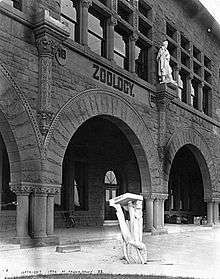
After Agassiz came to the United States, he wrote prolifically on polygenism, which holds that animals, plants, and humans were all created in "special provinces" with distinct populations of species created in and for each province, and that these populations were endowed with unequal attributes.[42] Agassiz denied that migration and adaptation could account for the geographical age or any of the past. Adaptation takes time; in an example, Agassiz questioned how plants or animals could migrate through regions they were not equipped to handle.[43] According to Agassiz the conditions in which particular creatures live "are the conditions necessary to their maintenance, and what among organized beings is essential to their temporal existence must be at least one of the conditions under which they were created".[43] Agassiz was opposed to monogenism and evolution, believing that the theory of evolution reduced the wisdom of God to an impersonal materialism.[43]
Agassiz was influenced by philosophical idealism and the scientific work of Georges Cuvier. Agassiz believed one species of humans exists, but many different creations of races occurred.[43] These ideas are now included under the rubric of scientific racism. According to Agassiz, genera and species were ideas in the mind of God; their existence in God's mind prior to their physical creation meant that God could create humans as one species, yet in several distinct and geographically separate acts of creation. Agassiz was in modern terms a creationist who believed nature had order because God created it directly. Agassiz viewed his career in science as a search for ideas in the mind of the creator expressed in creation.
Agassiz, like other polygenists, believed the Book of Genesis recounted the origin of the white race only and that the animals and plants in the Bible refer only to those species proximate and familiar to Adam and Eve. Agassiz believed that the writers of the Bible knew only of regional events; for example that Noah's flood was a local event known only to the regions near those populated by ancient Hebrews.[43]
Stephen Jay Gould asserted that Agassiz's observations sprang from racist bias, in particular from his revulsion on first encountering African-Americans in the United States.[44] However, others have asserted that, despite favoring polygenism, Agassiz rejected racism and believed in a spiritualized human unity.[43] Agassiz believed God made all men equal, and that intellectualism and morality, as developed in civilization, make men equal before God.[43] Agassiz never supported slavery and claimed his views on polygenism had nothing to do with politics;[45] however his views on polygenism emboldened proponents of slavery.[37]
Accusations of racism against Agassiz have prompted the renaming of landmarks, schoolhouses, and other institutions (which abound in Massachusetts) that bear his name.[30] Opinions on these events are often mixed, given his extensive scientific legacy in other areas.[46] In 2007, the Swiss government acknowledged his "racist thinking," but declined to rename the Agassizhorn summit.[47] In 2017, the Swiss Alpine Club declined to revoke Agassiz's status as a member of honor, which he received in 1865 for his scientific work, because the club considered this status to have lapsed on Agassiz's death.[48]
Works
- Recherches sur les poissons fossiles (1833–1843)
- History of the Freshwater Fishes of Central Europe (1839–1842)
- Études sur les glaciers (1840)
- Études critiques sur les mollusques fossiles (1840–1845)
- Nomenclator Zoologicus (1842–1846)
- Monographie des poissons fossiles du Vieux Gres Rouge, ou Systeme Devonien (Old Red Sandstone) des Iles Britanniques et de Russie (1844–1845)
- Bibliographia Zoologiae et Geologiae (1848)
- (with A. A. Gould) Principles of Zoology for the use of Schools and Colleges (Boston, 1848)
- Lake Superior: Its Physical Character, Vegetation and Animals, compared with those of other and similar regions (Boston: Gould, Kendall and Lincoln, 1850)
- Contributions to the Natural History of the United States of America (Boston: Little, Brown, and Co., 1857–1862)
- Geological Sketches (Boston: Ticknor & Fields, 1866)
- A Journey in Brazil (1868)
- De l'espèce et de la classification en zoologie [Essay on classification] (Trans. Felix Vogeli. Paris: Bailière, 1869)
- Geological Sketches (Second Series) (Boston: J.R. Osgood, 1876)
- Essay on Classification, by Louis Agassiz (1962, Cambridge)
See also
- Category:Taxa named by Louis Agassiz
- List of geologists
References
- Nicolaas A. Rupke, Alexander von Humboldt: A Metabiography, University of Chicago Press, 2008, p. 54.
- Frank Leslie's new family magazine. v. 1 (1857), p. 29
- Woodward 1911, p. 367.
- Andrea Wulf, The Invention of Nature: Alexander von Humboldt's New World. New York: Alfred A. Knopf 2015, p. 250
-

- "Agassiz's Fossil Fish". The Geological Society.
- E.P. Evans: "The Authorship of the Glacial Theory", North American review Volume 145, Issue 368, July 1887. Accessed on January 24, 2018.
- Cameron, Dorothy (1964). Early discoverers XXII, Goethe-Discoverer of the ice age. Journal of glaciology (PDF).
- Louis Agassiz: Études sur les glaciers, Neuchâtel 1840. Digital book on Wikisource. Accessed on February 25, 2008.
- Woodward 1911, pp. 367–368.
- Woodward 1911, p. 368.
- Smith, p. 52.
- "Book of Members, 1780–2010: Chapter A" (PDF). American Academy of Arts and Sciences. Retrieved April 6, 2011.
- Dupree, A. Hunter (1988). Asa Gray, American Botanist, Friend of Darwin. Baltimore, MD: Johns Hopkins University Press. pp. 152–154, 224–225. ISBN 978-0-801-83741-8.CS1 maint: ref=harv (link)
- Dupree, A. Hunter (1988). Asa Gray, American Botanist, Friend of Darwin. Baltimore, MD: Johns Hopkins University Press. pp. ix–xv, 152–154, 224–225. ISBN 978-0-801-83741-8.CS1 maint: ref=harv (link)
- Smith (1898), pp. 39–41.
- Smith (1898), pp. 52–66.
- Agassiz, Elizabeth Cabot Cary (1893). Louis Agassiz; his life and correspondence. MBLWHOI Library. Boston and New York, Houghton, Mifflin and company.
- A History of Cornell by Morris Bishop (1962), p. 83.
- Irmscher, Christoph (2013). Louis Agassiz: Creator of American Science. Houghton Mifflin Harcourt.
- Museum of Fine Arts (1918). "Quincy Adams Shaw Collection". Boston, Massachusetts: Museum of Fine Arts: 2. Cite journal requires
|journal=(help) - Dexter, R.W. (1980). "The Annisquam Sea-side Laboratory of Alpheus Hyatt, Predecessor of the Marine Biological Laboratory at Woods Hole, 1880–1886". In Sears, Mary; Merriman, Daniel (eds.). Oceanography: The Past. New York: Springer. pp. 94–100. doi:10.1007/978-1-4613-8090-0_10. ISBN 978-1461380900. OCLC 840282810.
- James, William. "Louis Agassiz, Words Spoken. ... . at the Reception of the American Society of Naturalists. ... . [Dec 30, 1896]. pp. 9–10. Cambridge, 1897. Quoted in Cooper 1917, pp. 61–62.
- Erlandson, David A.; et al. (1993). Doing Naturalistic Inquiry: A Guide to Methods. Sage Publications. pp. 1–4. ISBN 978-0803949386.; Originally published in: Scudder, Samuel H. (April 4, 1874). "Look at your fish". Every Saturday. 16: 369–370.
- Shaler, Nathaniel; Shaler, Sophia Penn Page (1909). The Autobiography of Nathaniel Southgate Shaler with a Supplementary Memoir by his Wife. Boston: Houghton Mifflin Company. pp. 92–99.
- Cooper, Lane (1917). Louis Agassiz as a Teacher: Illustrative Extracts on his Method of Instruction. Ithaca: The Comstock Publishing Company.
- Pound, Ezra (2010). ABC of Reading. New York: New Directions. pp. 17–18. ISBN 978-0811218931.
- Emling 2009, pp. 169–170
- "Committee Renames Local Agassiz School | News | The Harvard Crimson". www.thecrimson.com.
- "Archived copy" (PDF). Archived from the original on June 7, 2010. Retrieved October 3, 2005.CS1 maint: archived copy as title (link) CS1 maint: unfit url (link). cambridgema.gov
- "Agassiz". mpshistory.mpls.k12.mn.us. Retrieved July 6, 2017.
- Schmadel, Lutz D. (2012). Dictionary of Minor Planet Names. Springer Science & Business Media. p. 176. ISBN 978-3642297182.
- Beolens, Bo; Watkins, Michael; Grayson, Michael (2011). The Eponym Dictionary of Reptiles. Baltimore: Johns Hopkins University Press. xiii + 296 pp. ISBN 978-1-4214-0135-5. ("Agassiz, J.L.R.", p. 2).
- "Louis Agassiz Medal". European Geosciences Union. 2005. Retrieved February 8, 2015.
- "Who Should Own Photos of Slaves? The Descendants, not Harvard, a Lawsuit Says". March 20, 2019. Retrieved March 29, 2019.
- Moser, Erica. "Descendants of racist scientist back Norwich woman in fight over slave images". theday.com. The Day. Retrieved June 21, 2019.
- Browning, Kellen. "Descendants of slave, white supremacist join forces on Harvard's campus to demand school hand over 'family photos'". www.bostonglobe.com. The Boston Globe. Retrieved June 21, 2019.
- "The World Is Watching: Woman Suing Harvard for Photos of Enslaved Ancestors Says History Is At Stake". Democracy Now!. March 29, 2019. Retrieved March 29, 2019.
- Tony Marco, Ray Sanchez and. "The descendants of slaves want Harvard to stop using iconic photos of their relatives". /www.cnn.com. CNN. Retrieved June 21, 2019.
- "Earthquake impacts on prestige". Stanford University and the 1906 earthquake. Stanford University. Retrieved June 22, 2012.
- Edward Lurie, "Louis Agassiz and the Races of Man," Isis 45, no. 3 (1954): 227–242.
- Paul M. Blowers, 2008, "Entering 'This Sublime and Blessed Amphitheatre': Contemplation of Nature and Interpretation of the Bible in the Patristic Period, In "Nature and Scripture in the Abrahamic Religions: Up to 1700", 2 vols (Scott Mandelbrote & Jitse van der Meer, Eds.), doi:10.1163/ej.9789004171916.i-782, book ISBN 9789047425236, pp. 147–176, esp. 159–164 and 151–154, chapter doi:10.1163/ej.9789004171916.i-782.34}, accessed June 8, 2014.
- Gould, Stephen Jay (1980). "Flaws in a Victorian Veil, Chapter 16". The Panda's Thumb.
- John P. Jackson, Nadine M. Weidman Race, Racism, and science: social impact and interaction, Rutgers University Press, 2005, p. 51
- See for instance: Author needed, 2001, "Political Correctness Run Amok: School Students Dishonor a Genius of Science", Journal of Blacks in Higher Education, no. 32 (Summer 2001): 74–75.
- "Louis Agassiz vom Sockel holen und dem Sklaven Renty die Würde zurückgeben". Die Bundesversammlung – Das Schweizer Parlament. September 14, 2007.
- "Louis Agassiz ne sera pas déchu de son titre au Club alpin suisse". Le Temps (in French). August 23, 2017. Retrieved August 23, 2017.
Sources

- Dexter, R W (1979). "The impact of evolutionary theories on the Salem group of Agassiz zoologists (Morse, Hyatt, Packard, Putnam)". Essex Institute Historical Collections. 115 (3). pp. 144–71. PMID 11616944.
- Emling, Shelley (2009). The Fossil Hunter: Dinosaurs, Evolution, and the Woman whose Discoveries Changed the World. Palgrave Macmillan. ISBN 978-0-230-61156-6.CS1 maint: ref=harv (link)
- Irmscher, Christoph (2013). Louis Agassiz: Creator of American Science. Houghton Mifflin Harcourt. ISBN 978-0547577678.CS1 maint: ref=harv (link)
- Lurie, E (1954). "Louis Agassiz and the races of Man". Isis; an International Review Devoted to the History of Science and Its Cultural Influences. 45 (141) (published September 1954). pp. 227–42. PMID 13232804.
- Lurie, Edward (1988). Louis Agassiz: A Life in Science. Johns Hopkins University Press. ISBN 978-0801837432.
- Lurie, Edward (2008). "Agassiz, Jean Louis Rodolphe". Complete Dictionary of Scientific Biography. 1. Detroit: Charles Scribner's Sons. pp. 72–74.
- Mackie, G O (1989). "Louis Agassiz and the discovery of the coelenterate nervous system". History and Philosophy of the Life Sciences. 11 (1). pp. 71–81. PMID 2573108.
- Menand, Louis (2002). "Agassiz". The Metaphysical Club: A Story of Ideas in America. Macmillan. pp. 97–116. ISBN 978-0374528492.
- Numbers, Ronald L. (2006). The Creationists: From Scientific Creationism to Intelligent Design (2nd ed.).
- Rogers, Molly (2010). Delia's Tears: Race, Science, and Photography in Nineteenth-Century America. Yale University Press. ISBN 978-0300115482.
- Smith, Harriet Knight, The history of the Lowell Institute, Boston: Lamson, Wolffe and Co., 1898.
- Winsor, M P (1979). "Louis Agassiz and the species question". Studies in History of Biology. 3. pp. 89–138. PMID 11610990.

External links
| Wikiquote has quotations related to: Louis Agassiz |
| Wikimedia Commons has media related to Louis Agassiz. |
| Wikisource has original works written by or about: Louis Agassiz |
| Wikispecies has information related to Louis Agassiz |
- Publications by and about Louis Agassiz in the catalogue Helveticat of the Swiss National Library
- Works by Louis Agassiz at Project Gutenberg
- Works by or about Louis Agassiz at Internet Archive
- Works by Louis Agassiz at LibriVox (public domain audiobooks)

- Works by Louis Agassiz online at the Biodiversity Heritage Library.
- Weisstein, Eric Wolfgang (ed.). "Agassiz, Jean (1807–1873)". ScienceWorld.
- Pictures and texts of Excursions et séjours dans les glaciers et les hautes régions des Alpes and of Nouvelles études et expériences sur les glaciers actuels by Louis Agassiz can be found in the database VIATIMAGES.
- "Geographical Distribution of Animals", by Louis Agassiz (1850)
- Runner of the Mountain Tops: The Life of Louis Agassiz, by Mabel Louise Robinson (1939) – free download at A Celebration of Women Writers – UPenn Digital Library
- Thayer Expedition to Brazil, 1865–1866 (Agassiz went to Brazil to find glacial boulders and to refute Darwin. Dom Pedro II gave his support for Agassiz's expedition on the Amazon River.)
- Louis Agassiz Correspondence, Houghton Library, Harvard University
- Illustrations from 'Monographies d'échinodermes vivans et fossiles'
- National Academy of Sciences Biographical Memoir
- Agassiz, Louis (1842) "The glacial theory and its recent progress" The Edinburgh New Philosophical Journal, vol. 33. p. 217–283. (Linda Hall Library)
- Agassiz, Louis (1863) Methods of study in natural history – (Linda Hall Library)
- Agassiz Rock, Edinburgh – during a visit to Edinburgh in 1840, Agassiz explained the striations on this rock's surface as due to glaciation
